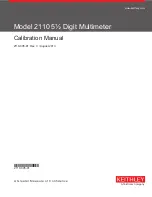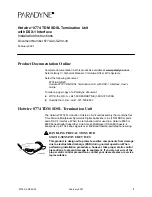
2
3.1 AC VOLTS
There are two ranges for measuring AC voltage, 200 V and 500 V.
For more accurate measurements under 200 volts use the 200 Volt setting.
1. Connect the black test lead to the "COM" terminal and the red test lead
to the "V/
Ω
" input terminal.
2. Set the function/range switch to the appropriate AC V range shown above.
3. Touch the test leads to the circuit under test. With AC voltage,
the polarity of the test leads is not a factor.
NOTE: It is best to touch one of the test leads to ground or
Neutral first and then touch the 2nd test lead to the hot wire.
4. Read the value of the measurement displayed.
5. Typical AC Voltage measurements include wall outlets, appliance outlets, motors,
light fixtures and switches. When measuring outlets the specially spaced lead
holders allow for single one hand testing.
Resistance
DC Volts
AC Volts
Battery test
3.0 OPERATING INSTRUCTIONS
DIAL SETTINGS
DANGER is reserved for conditions and actions that are likely to cause serious or fatal injury.
WARNING is reserved for conditions and actions that can cause serious or fatal injury.
CAUTION is reserved for conditions and actions that can cause injury or instrument damage.
DANGER
• Never make measurement on a circuit in which voltage over 1000V exists.
• Do not exceed the CAT rating of the measuring device
• Do not attempt to make measurement in the presence of flammable gases. The use of the instrument may cause sparking, which can lead to an explosion.
• Never use the instrument if its surface or your hand is wet.
• Do not exceed the maximum allowable input of any measuring range.
• Never open the battery cover during a measurement.
• The instrument is to be used only in its intended applications or conditions.
Use in other than as intended may cause instrument damage or serious personal injury.
WARNING
• Never attempt to make any measurement if any abnormal conditions are noted, such as broken case,
cracked test leads and exposed metal part.
• Do not turn the function selector switch with plugged in test leads connected to the circuit under test.
• Do not install substitute parts or make any modification to the instrument. Return the instrument to your distributor for repair or recalibration.
• Do not try to replace the batteries if the surface of the instrument is wet.
• Always switch off the instrument before opening the battery compartment cover for battery replacement.
CAUTION
• Set the Function Switch to an appropriate position before starting measurement.
• Firmly insert the test leads.
• Disconnect the test leads from the instrument for current measurement.
• Do not expose the instrument to the direct sun, high temperature and humidity or dewfall.
• Be sure to power off the instrument after use. When the instrument will not be in use for a long period, place it in storage after removing the batteries.
• Use only a soft cloth dampened with water or neutral detergent for cleaning the meter. Do not use abrasives, solvents or harsh chemicals.
Allow to dry thoroughly before use.
The marking “
” on the equipment represents Caution, risk of electric shock.
The marking “
” on the equipment represents Caution, risk of danger.
The marking “ ” on the equipment represents Functional earth terminal.
The marking “ ” on the equipment represents Equipment protected by DOUBLE INSULATION or REINFORCED INSULATION.
Use extreme caution when using this multimeter. Improper use of this meter can result in severe damage to property, severe personal injury or
death. Follow all instructions and suggestions in this operators manual as well as observing normal electrical safety precautions. Do not use this
meter if you are unfamiliar with electrical circuits and proper test procedures.
2.1 SAFETY WARNINGS
• This instruction manual contains warnings and safety rules which must be observed by the user to
ensure safe operation of the instrument and retain it in safe condition.
• Read through and understand the instructions contained in this manual before using the instrument.
• Keep the manual at hand to enable quick reference whenever necessary.
• The instrument is to be used only in its intended applications.
• Understand and follow all the safety instructions contained in the manual.
• It is essential that all safety instructions are adhered to.
• Failure to follow the safety instructions may cause injury, instrument damage
The symbol
indicated on the instrument means that the user must refer to the related parts in the manual for safe operation
of the instrument. It is essential to read the instructions wherever the symbol appears in the manual.





















